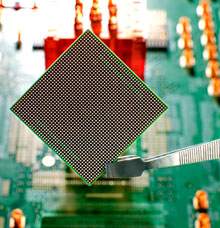Just when you thought the iPad was the coolest item in your electronics arsenal, the iPad2 comes along and all of a sudden, the original iPad isn’t as feature-rich as it seemed before.
But the rapid fall into obsolescence is not a problem affecting just the iPad – this trend is reflected with all consumer electronics.

However, there is a new microchip with the potential to change the status quo. It is a reprogrammable, low cost chip capable of self-rearranging its design on demand.
That way, when a manufacturer wants to add functionality, the logic gates of the chip can be modified to implement the new feature. Thus, consumers may be able to avoid buying a new model or physically replacing the old chip.
The reprogrammable chip is built by Tabula, a tech start up. Tabula’s chip is a less costly yet more powerful alternative to current reprogrammable chips such as FPGA (field programmable gate array). FPGAs are usually used in low volume, high cost devices such as CT scanners where regularly buying a new model to replace an older model is prohibitive and impractical.
Tabula’s cost advantage over FPGAs is mostly as a result of its smaller size and reduced cost. Indeed, the large size of FPGA chips not only drives up the cost – it also slows down the performance of the chip given the distances signals have to travel on the chip surface.
If the FPGA is a large single story building, consider Tabula’s chip to be a multistoried building achieving the same ‘volume’ but with considerably smaller footprint. Signals thus travel shorter distances.
While the concept of 3D chips has so far remained behind the closed doors of tech research labs, Tabula has developed a technique that makes a single level chip respond in the same way as a 3D chip. Tabula’s chip cycles between eight different layouts at speeds of up to 1.6Ghz – an impressive speed for a reprogrammable chip.
[Via Technology Review]






